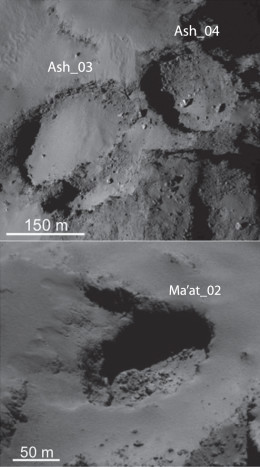High-resolution imagery of comet 67P Churyumov–Gerasimenko has revealed that its surface is covered in active pits — some measuring hundreds of meters both wide and deep! But what processes caused these pits to form?
Pitted Landscape
ESA’s Rosetta mission arrived at comet 67P in August 2014. As the comet continued its journey around the Sun, Rosetta extensively documented 67P’s surface through high-resolution images taken with the on-board instrument NavCam. These images have revealed that active, circular depressions are a common feature on the comet’s surface.
In an attempt to determine how these pits formed, an international team of scientists led by Olivier Mousis (Laboratory of Astrophysics of Marseille) has run a series of simulations of a region of the comet — the “Seth” region — that contains a 200-meter-deep pit. These simulations include the effects of various phase transitions, heat transfer through the matrix of ices and dust, and gas diffusion throughout the porous material.
Escaping Volatiles

Additional examples of pitted areas on 67P’s northern-hemisphere surface include the Ash region and the Ma’at region (both imaged September 2014 by NavCam) [Mousis et al. 2015]
The authors’ simulations demonstrate that volatiles trapped beneath the comet’s surface — either in icy structures called “clathrates” or within amorphous ice — can be suddenly released as the comet warms up. The team shows that the release of volatiles from these two structures can create 200-meter-deep pits within ~800 years and ~2,000 years, respectively. Since comet 67P has been around the inner solar system for about 7,000 years, both of these processes are viable explanations for the pits.
The simulations also show that direct sublimation of crystalline ices of water, carbon monoxide, and carbon dioxide can cause deep pits — but only in the absence of a surface layer of dust, known as a “dust mantle,” in that region of the comet. Direct sublimation could be a viable explanation for the pits, then, if dust grains in the area are so small that they are carried away with the released gas, rather than falling back to form a layer on the comet’s surface.
Regardless of the formation mechanism for these pits, the authors conclude that their very existence implies that the physical and chemical properties across the surface and subsurface of the comet cannot be uniform. Further observations from Rosetta will continue to help us understand comet 67P.
Citation
O. Mousis et al 2015 ApJ 814 L5. doi:10.1088/2041-8205/814/1/L5
